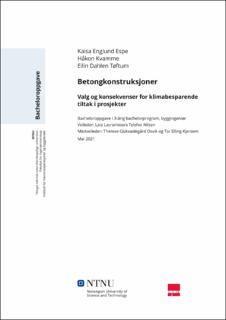| dc.contributor.advisor | Nilsen, Lala Lacramioara Telehoi | |
| dc.contributor.advisor | Kjersem, Tor Elling | |
| dc.contributor.advisor | Osvik, Therese Giskeødegård | |
| dc.contributor.author | Espe, Kaisa Englund | |
| dc.contributor.author | Kvamme, Håkon | |
| dc.contributor.author | Tøftum, Eilin Dahlen | |
| dc.date.accessioned | 2021-09-24T19:19:56Z | |
| dc.date.available | 2021-09-24T19:19:56Z | |
| dc.date.issued | 2021 | |
| dc.identifier | no.ntnu:inspera:82686915:82688611 | |
| dc.identifier.uri | https://hdl.handle.net/11250/2782235 | |
| dc.description.abstract | Oppgaven sammenligner informasjon om utslipp og pris for ulike betong- og lavkarbonklasser, og hvilke andre tiltak som kan gjøres for å optimalisere klimareduksjon basert på erfaringer fra byggebransjen. Hovedmålet med oppgaven er å undersøke forholdet mellom den økonomiske konsekvensen ved bruk av ulike klasser lavkarbonbetong og den faktiske miljøbesparelsen det gir. I tillegg til dette har oppgaven som mål å finne ut hvilke andre løsninger knyttet til betong som kan bidra til klimagassreduksjon. Oppgaven skal bidra til å gi et grunnlag for å kunne ta bedre valg rundt karbonklasser i prosjekter.
Oppgaven tar utgangspunkt i prosjektet Emblem skule, verdier hentet fra Dyrøy Betong, og informasjon hentet inn gjennom en innholdsanalyse. Arbeidet går ut på å hente inn verdier for pris og klimagassutslipp fra Dyrøy på betongtyper som var relevante for prosjektet Emblem skule, og sammenlikne disse. Det blir også gjort en innholdsanalyse knyttet til erfaringer ved bruk av lavkarbonbetong og andre metoder for å redusere utslipp fra betong.
Basert på resultatene presentert i oppgaven kan det konkluderes med at det er mange måter å bidra til reduksjon av utslipp og det finnes ikke en konkret løsning, ettersom alle prosjekter og betongkonstruksjoner er unike. For å spare klimagassutslipp og kostnader i et prosjekt må man altså se hele prosjektet i sammenheng, og finne de tiltakene som gir den største gevinsten i hvert enkelt tilfelle. Det er alle disse enkeltinnsparingene som sammen bidrar til reduksjonen av det totale klimagassutslippet. | |
| dc.description.abstract | The thesis compares information on emissions and prices for different concrete and low-carbon classes, and what other measures can be taken to optimize climate reduction based on experience from the construction industry. The main purpose for the thesis is to examine the relationship between the economic consequences of utilizing different classes of low-carbon concrete and the actual environmental savings it provides. In addition to this, the thesis aims to find out which other solutions related to concrete can contribute to greenhouse gas reduction. The thesis will be a frame of reference to make better choices about carbon classes in their future projects.
The thesis is based on the project Emblem skule, data obtained from Dyrøy Betong, and information collected through a content analysis. The work involves collecting values for prices and greenhouse gas emissions from Dyrøy on concrete types that were relevant to the project Emblem skule and comparing these. A content analysis is also carried out in relation to experiences utilizing low-carbon concrete and other methods for reducing emissions from concrete.
Based on the results presented in the thesis, it can be concluded that there are many ways to contribute to the reduction of emissions and there is no distinct solution, as all projects and concrete structures are unique. To save greenhouse gas emissions and project costs one must therefore look at the entire project in context and find the measures that provide the greatest benefit in each individual case. In the end it is these individual changes that when combined contribute to a reduction of total greenhouse gas emission. | |
| dc.language | nob | |
| dc.publisher | NTNU | |
| dc.title | Betongkonstruksjoner - Valg og konsekvenser for klimabesparende tiltak i prosjekter | |
| dc.type | Bachelor thesis | |
